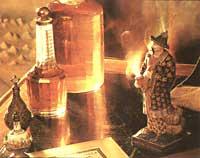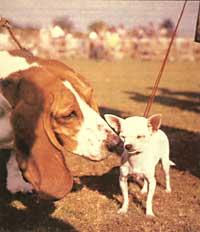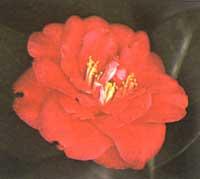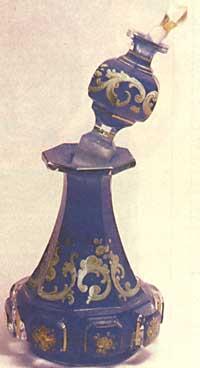Smell of smell
“Perfume”, by Patrick Süskind

The highest is a fragment extracted from the first page of Patrick Süskind's Perfume Bottle, a hit of four or five years ago. This work tells the life of a character with a unique smell. For those who have not read the book, here we will not tell you the thread of history, but we will take advantage of what Süskind has written to explain some interesting aspects about smell.
In these initial lines, for example, writers XVIII. It has described both the aromatic society and the twentieth century, and to warn the reader of uneven and undesirable odors, it has been necessary to mention the sources of odors: sweat, chis, paved teeth, manure, old goat... For something I would write like this. Süskind was not going to be slower than anyone describing odors. And it is that, if the likes are able to distinguish between tastes, good and bad odors, but when we have to determine what odors we speak, we can hardly make known to anyone a certain smell so that it can identify it exactly if it does not associate it to something of the experience.
It is not so with the colors, at least with the most basic and used. There is a specific lexicon to designate colors in all languages. If we had to act like smells, we would say red the color of blood, blue the color of the sea or sky, green the color of grass, etc. It is undeniable that there are some such color words created, such as orange or pink, but there are not many even those we consider basic.
If there are special words to describe the smell, the most remarkable thing is the smell we use to express certain types of bad smells. Others, although not words characteristic for the smell, can be considered especially related. One of them is the corrupt term. In fact, it represents a state of organic matter (rot), and in that state we also express the bad smells that produce the different substances, although they are often different (such as fish and meat).

In this regard we have the problem of odour classes. We are able to distinguish thousands of odors, but on this occasion, unlike what happens with colors, the obstacles to associating odors to different types are enormous. Taste, although with a lower degree of precision than vision, from this perspective would be above the smell. At least four basic flavors (salted, sweet, sour and sour) are often distinguished, although attempts to prove that all real flavors are a combination of these four do not yet have a clear conclusion.
It has been tried to describe this type of simple odors and the results, in fact, are less than in the case of taste. A proposed classical classification is as follows, for example:
Smell of fruit / Smell of flower / Smell of spices / Smell of you / Smell of burnt / Smell of resin / Smell of mussels.
Among the conditions that the classification should meet, the main one is that a particular smell can be assigned a single series and at least one. It is known that not all flowers have the same smell (nor all putrid materials), but it can be recognized that there is some affinity. But we would talk about the smell of cheese and we could hardly put it in any of the previous sections. A new department. Unfortunately, the same happens with a lot of smells, hence the abundance of lists that are proposed to classify odors.
Süskind says about his character:
...everything that accumulated as a concept of odors to name them, the common language would soon be short...In each step and in each breath were endowed with different odors and, therefore, animated by a different identity, earth, landscape, air... also had to be expressed with those three words... All these imbalances between the rich world inherited from the smell and the poverty of language, created doubts about the meaning of language in the young Grenouille.
As we have said, we identify odors with language as a reference, we have no differentiated words like red or salted to describe odors. Grenouille complained about it, but it also seems logical that this happens, if we take into account what is basically the smell. While the visual and auditory agents are the waves, and the sensation varies depending on the specific characteristics of the same (frequency and intensity), smell, along with taste, is a totally different phenomenon: the agent is a substance dissolved in the air. Through a process still known but certainly not simple, aromatic substances stimulate our olfactory nerve and each produces a different feeling.

The odors we usually receive are combinations of smells of pure volatile substances. We would all know how to distinguish between certain odors that of strawberries, but there are no discrete phenomena. It must be taken into account that 35 chemical substances are involved in the formation of the smell of strawberries; in the smell of white bread 70 ingredients have been separated, and in coffee until now they have been identified and obtained 103, it is estimated that 150 substances can be involved in this smell. Grenouill was going to have an exaggerated smell, but we did not distinguish odors either.
The average process outlined in the previous lines is that of chemoreception, the capacity developed by living beings to respond to the stimuli of the surrounding chemical compounds and to emit the signal to the brain. In the smell a distant chimiorrecepción occurs and in the tactile taste. As mentioned above, little is known about what happens after a chemical hit the pituitary of the nostril, so there are as many theories as you want.
According to one of them, the stimulating molecule is absorbed by the receptor and the resulting complex alters the permeability to the ions of the cell membrane, producing an electrogenesis. Another idea is that in the cell membrane there is a kind of holes of different size and when the olfactory molecule adapts well, somehow signals are created. The size of the molecule would then be the determinant of the smell. Others have confirmed that receiving cells constantly emit infrared waves and the olfactory substance would have an infrared absorption band.
On the other hand, the session has focused on finding correspondence between the chemical structure of the molecules and the smell. In the results there is everything. Some benzene derivatives have a similar smell, for example. In fact, the first compounds of this category were found in plants of fine aromas, hence the name of aromatic, which was then used for the whole family of benzene derivatives, with or without aromatic smell (and some do not have very good smell! ). On other occasions, there is no correlation and, for example, there are stereoisomers with different olorative characteristics (composed of the same chemical formula but with different spatial configuration).

Therefore, the fundamental cause of the smell is quite dark. Another task of the theories that want to clarify is, in addition, to explain some characteristics of smell. One of them is the adaptation to the smell.
When we are smelling, we need increasing concentrations to feel ourselves, and many times we become accustomed completely to not being aware of the smell. But the lack of sensitivity does not seem persistent, since if we move away from the source of the smell and we feel again as at the beginning. The same continuous and prolonged smell can, however, provoke a long-term adaptation. See what Grenouill thought when he realized he did not smell:
It's not about me having no smell, because everything has its own. The reason I don't smell is because of the fact that I have ingested it continuously, and I have my nose closed for him. If I were able to separate myself from myself, at least, totally or partially, and after resting for a while trying to go back, I would take my smell well and, therefore, I could use myself.
Another striking feature of the smell is the low concentration of stimuli necessary. It says 10,000 times more sensitive than taste. The detection threshold of garlic ethylmercaptan is usually 1/23x10 6 mg/l, for example. On the other hand, for changes in odour intensity to be observed, it is necessary to increase the concentration of odors around 30-50%, and more if it is low.
Furthermore, it is known that the smell of people is not as demanding as that of other animals. The most mentioned example is that of the dog. The dog has about 200 million odour receptors in the nostrils, 20 times more than the person. There are few olfactory foxes made by dogs. Some may be excessive. The belief that a dog can follow the footprint left a day or two before in an open place has a lot of imagination. Just a few hours for the smell to disappear, and in a dry and hot environment can be a matter of minutes. But if you have captured the footprint, the dog knows how to travel long distances behind it.
To observe a little how our nervous system makes the recitation, emission and perception of olfactory sensations will open the doors of one of the most curious aspects of smell. Before we have talked about receiving cells, but we have not said, unlike other senses, that these cells are authentic neurons. There is nothing like the eardrum of the ear, the cornea of the eye, or the papilla of the tongue that differentiates between the outer world and the neurone of the nerve. The nerve is the one that then works as a receptor.

On the other hand, these neurons, unlike other sensations, are regenerative. In case of death or deterioration of one, a new one will be created to fulfill its task. This does not usually occur with other neurons of the body and much less if they are heludas and the central system. That is why the injury that has affected some of the nerves is so serious, since it can henceforth produce the corresponding incapacitation. In trials with several animals, it has been detected that the olfactory bulb has been eliminated and the bulb of new neurons has been regenerated in the brain.
All this has generated different reflections. On the one hand, in the senses one can think that it is one of the most primitive in the senses, understanding the differentiation of the middle nerve as an improvement derived from evolution. In fact, the chimiorreceptors of inferior invertebrates are free nervous extremes, while in more evolved species the secondary chemorreceptors are more common. In this line it can be understood that the human being, being the most developed in living beings, is more obtuse or, if preferred, more dependent on vision and hearing. But others consider that only the importance of smell in life can determine the regeneration of olfactory neurons. Rat, for example, can live blind without major problems, but if you can't smell, you can find a couple or food.
Chemoreceptor neurons are found in the olfactory epithelium of the nose, from where the nerves are collected to the olfactory bulb. In each structure called local glomerulu stimuli are collected from thousands of receptors and the complexities of odors are reduced. The signal sent to the brain goes directly to the limbic system. The limbic system is closely related to memory and emotions. It is not the headquarters of the memory, but that of the regulatory system necessary to revive the experience. In the first living it is dedicated almost exclusively to the smell and occupies much of the brain of the animal.
And in us, in every sense, smell is the most directly related to the limbic system. The memory of the person who in his day knew the perfume of the soap that the person used, or the smell that was habitual in one place, when we take it elsewhere or in another, comes suddenly. It can be said that it is more than a memory: we again feel the emotions and feelings of that time. But on the other hand, we cannot remember the odors. We can build images in our mind without closing our eyes, or feel a melody without singing, but if we say that the smell of the cooked bark is felt inside again, we will realize that we cannot achieve it. Here are his curiosities.

In addition to being related to memory and emotions, the limbic system also has to do with the production of hormones that regulate our metabolism, our sexual activity and our social behavior, affecting the hypotalamo and the pituitary gland that deal with it. It is known that in the life of many animals the smell, or more specifically the distant chimiorrecepción, has a great importance. The substances that function as regulatory messages of behavior among animals of the same species are pheromones, used by insects to organize their complex societies. Bees locate the flower or ants to rejuvenate their companions; queens bees to keep their command by imitating other bees; or to warn of a danger, these insects secrete pheromones, such as flights and movements.
It is observed that many fish and mammals have this type of communication and management systems. Salmon, mice, dogs, pigs, etc. have been studied. long and the importance of odors has been proven. However, men and women endowed with intelligence and reasoning have always seen animals from above at times when they have to match the females or mark the territory, for example, depending on the smell. Almost everyone would accept that smell is a secondary sense of sight and hearing. It is evident that being blind or deaf is sadder than being without odors. It seems that since we got up on the two legs and began to look around, the importance that the smell could have before has come from top to bottom. Is this so? Does man live free from the clutches of smell?
Many believe it, but there are studies that show that more than one of our activities is governed by smell. Sometimes without realizing that substances with a concentration lower than our threshold of odors can influence us or we have become accustomed to that smell. We have no smell, but something has influenced us in the background. This is the case of the smell of sweat. Of course, the smell of sweat, especially that of some, we take it well, but we get used on one side and there are substances of low concentration. One of the components of our sweat is androsterone.
It has been discovered that this substance has a role in the pairing of pigs (by smelling the androsterone, without moving the curls, desperate, it accepts the coating of the plates). The man throws more androsterone than the woman, which is more sensitive to this smell. In an essay, in the dentist's office, he prepared a chair with an androsterone concentration that the smell could not consciously perceive and it seems that women tended to that chair, while men rejected it. It is known that when a group of women live long, the rule is synchronized and the reason is the sweat androsterone. During the time of ovulation, the woman has a more acute and obtuse smell when she has a ruler. Without this type of essays, just look at how they are and the lot of perfume ads that are made on television and in magazines, to realize that the smell can not be irrelevant in this society.

In these cases, the most commonly used message is a smell that increases the attraction between females. In the mountains of the Himalayas there is an animal of the family of the goat and the deer, called carabining ox ( Moschus moschiferus ), which for the value of the substance that is formed in a gland of his abdomen danger of extinction. What is the substance? Musketa in Arabic al-misk , a. C. C. Used since 3.500 in the pharmaceutical sector and a classic ingredient of the most appreciated perfumes. The characteristic smell of the carabiner is due to the muscona (3-methyl-1-cyclopentadecanone) and today there are many, about 300 synthetic substances of similar smell. In fact, for use in perfumery the original price is extremely expensive (25$ per gram in 1978, more expensive than gold; today half the price of gold) and you have had to look for alternatives.
Because the smell of the carabiner and its substitutes is not far from androsterone and the woman is more sensitive than the man. That is why things are not done. Just as animals will not be used, but it is undeniable that the smell does its work. There are those who say that kiss is the mark of an ancient usanza. Today, the Eskimo join the noses as a farewell, and the norms of the high society demand that when kissing a woman's hand no kiss is given, but only touch her with the tip of the nose. Perhaps for being finer some do, but perhaps for being animals, an unconscious demonstration of the importance of smell in us is made. On the other hand, Grenouille was very sure of the power of smell:
After one or two years, that perfume would reach its point of maturation, adopting an aggressiveness that would not leave anyone at peace. And the dominated, unarmed people were going to remain defenceless at the fascination of the girl, which no one knew the reason. And since people are naïve and use their nose only to breathe, all would have said that all this was due to the beauty, grace and slenderness of the girl... And no one would know that what conquered all of them was not really an appearance, which was not their outward beauty, supposedly perfect, but only their smell, without their excellent and similar smells.





